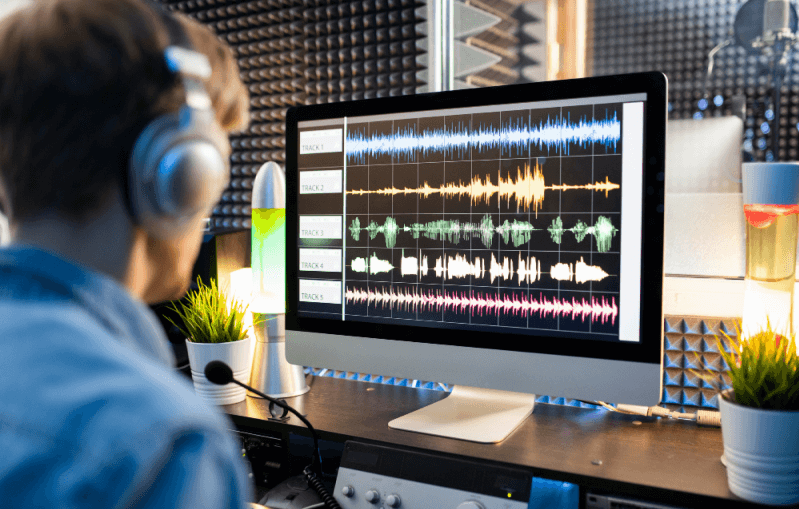How audio visual charlotte nc empowers marketing messages
Recognizing the Addition of Audio Visual Technology in Today's Educational Environments
The assimilation of audio-visual modern technology in academic setups has transformed the training and discovering process. Educators currently have access to tools that satisfy different finding out designs, boosting pupil involvement and cooperation. Nonetheless, the unification of these modern technologies offers both chances and challenges. Comprehending just how to efficiently implement these tools is necessary. What approaches can educators employ to make best use of the advantages of audio-visual technology in their class?
The Development of Audio-Visual Innovation in Education
As instructional demands progressed over the years, audio-visual technology went through significant improvements that improved the learning environment. Devices such as film projectors and slide shows were the main methods of integrating visual aspects right into class. These early modern technologies provided teachers with the capacity to existing information dynamically, yet they were limited in ease of access and interactivity.
With the arrival of videotape recorder in the 1970s, classrooms started to integrate documented lessons, broadening the scope of educational resources. The intro of computers in the 1980s additional revolutionized this landscape, permitting the production of multimedia presentations and interactive knowing experiences.
The increase of the web in the 1990s noted a zero hour, allowing real-time accessibility to a wealth of audio-visual materials. Today, digital devices such as interactive white boards and online learning platforms remain to improve the instructional experience, cultivating engagement and collaboration among students.
Advantages of Audio-Visual Devices for Diverse Learning Styles
Audio-visual devices play a necessary function in satisfying varied discovering designs by boosting visual discovering and enhancing acoustic involvement. By incorporating photos, video clips, and sound, these modern technologies produce a more comprehensive academic environment. This complex technique allows educators to resolve the different preferences and needs of trainees effectively.
Enhancing Visual Knowing
Involvement in the discovering procedure is considerably boosted via making use of audio-visual tools, satisfying various finding out styles. These devices, such as video clips, infographics, and interactive presentations, give visual stimulations that assist comprehension and retention. Visual learners, specifically, take advantage of the unification of pictures and animations, which can simplify intricate principles and improve understanding. In addition, audio-visual resources can illustrate real-world applications, making discovering more pertinent and engaging. By incorporating shade, motion, and sound, instructors can create a dynamic knowing environment that catches trainees' attention and cultivates deeper cognitive connections. Eventually, the critical use audio-visual innovation not just supports aesthetic learning but also enhances the total instructional experience for diverse students.
Improving Auditory Involvement
A significant benefit of incorporating audio-visual tools in education is their ability to improve acoustic interaction among pupils. These devices, which incorporate multimedia presentations, podcasts, and interactive audio components, deal with numerous finding out styles, particularly benefiting acoustic students (audio visual charlotte nc). By incorporating noise and narrative, instructors can create immersive experiences that record students' interest and strengthen comprehension. This engagement is essential, as it cultivates a much deeper understanding of the product and advertises retention. Furthermore, audio-visual devices can assist in collective knowing atmospheres, motivating pupils to take part in conversations and share their insights. Ultimately, the incorporation of audio-visual modern technology not just sustains auditory involvement yet likewise enriches the overall instructional experience, making finding out more dynamic and reliable for all trainees
Enhancing Engagement Through Interactive Understanding

Gamification aspects, such as tests and simulations, can improve inspiration and retention, making discovering extra pleasurable and reliable. These methods not just stimulate cognitive involvement but likewise accommodate varied discovering designs, guaranteeing that all pupils can participate meaningfully. Therefore, interactive understanding environments promote a feeling of area and belonging, inevitably resulting in enhanced scholastic outcomes. With the assimilation of audio aesthetic technology, instructors can change standard class into vivid areas where pupils thrive and actively form their educational journeys.
Connecting Concept and Experiment Multimedia Resources
Multimedia sources act as an essential link in between theoretical concepts and functional application in academic settings. By improving interaction, promoting joint understanding experiences, and sustaining varied discovering styles, these tools create a more comprehensive and vibrant understanding setting - audio visual charlotte nc. This technique not only fosters deeper understanding but also prepares students for real-world challenges

Enhancing Engagement Through Multimedia
Engagement in instructional settings considerably enhances when instructors include multimedia sources into their training methods. Using videos, podcasts, and interactive discussions improves the learning experience, permitting trainees to connect with the product on multiple degrees. Multimedia sources deal with numerous discovering designs, supplying visual, acoustic, and kinesthetic stimulations that can hold trainees' attention better than standard lecture approaches. In addition, these sources can streamline complicated ideas, making them much more easily accessible and unforgettable. By integrating multimedia, instructors can produce a dynamic classroom environment that cultivates inquisitiveness and encourages learners. Ultimately, the tactical use of audio-visual modern technology offers to connect the gap in between academic knowledge and sensible application, improving the instructional experience for both trainers and students.
Helping With Collaborative Discovering Knowledge
Numerous research studies show that collaborative discovering experiences significantly boost her latest blog student outcomes when incorporated with multimedia sources. Multimedia tools get redirected here assist in interaction among trainees, enabling them to take part in problem-solving and vital believing jointly. By utilizing video conferencing, collective systems, and interactive discussions, educators produce settings conducive to synergy and shared learning. These technologies make it possible for pupils to interact their concepts successfully and obtain instant comments, promoting a deeper understanding of the subject. Additionally, multimedia resources can present complicated concepts in more digestible styles, advertising conversation and cooperation. Therefore, the mix of joint discovering and audio-visual technology not just improves the instructional experience yet likewise prepares trainees for real-world team effort dynamics, emphasizing the importance of cooperation and collective expertise building and construction.
Sustaining Diverse Discovering Styles
While standard teaching methods frequently accommodate a limited variety of finding out choices, the assimilation of audio-visual modern technology supplies an extra comprehensive method to education. By using multimedia sources such as videos, interactive simulations, and electronic discussions, teachers can address numerous discovering styles, consisting of aesthetic, auditory, and kinesthetic. This flexibility allows for set apart guideline, enabling pupils to involve with material in ways that reverberate with their private preferences. Additionally, audio-visual tools can promote much deeper understanding by supplying multiple representations of complicated ideas. Because of this, trainees that may battle with traditional approaches can find different pathways to success, promoting a more fair knowing setting that sustains academic accomplishment for all learners.
Difficulties in Implementing Audio-Visual Innovation
Although audio-visual technology holds excellent promise for improving instructional experiences, its implementation commonly encounters considerable obstacles. One key worry is the economic concern connected with investing in and keeping such devices, which can strain budgets, particularly in underfunded organizations. Additionally, poor training for educators can prevent reliable integration, leaving them ill-prepared to make use of the innovation completely. Technical problems, such as software application breakdowns and compatibility issues, might likewise interrupt lessons and irritate both instructors and trainees. Additionally, differing levels of trainee access to technology outside the classroom can develop differences in finding out possibilities. Lastly, the capacity for over-reliance on innovation may diminish important mentor techniques, inevitably restricting the instructional experience. Addressing these challenges needs a complete technique, consisting of appropriate funding, professional development, and fair accessibility to resources, to assure that audio-visual innovation can be leveraged successfully in today's academic settings.
Finest Practices for Integrating Modern Technology in the Classroom

Additionally, fostering an interactive atmosphere through collaborative devices motivates pupil engagement and involvement. Making use of diverse audio-visual sources provides to different discovering styles, accommodating visual, auditory, and kinesthetic learners. Consistently evaluating the impact of technology on student understanding assists instructors refine their strategies and adapt to altering needs. Including trainees in the selection of modern technology promotes possession and inspiration. By adhering to these finest practices, teachers can produce a dynamic classroom environment that effectively integrates innovation and boosts the educational experience for all students.
The Future of Audio-Visual Modern Technology in Education
As class increasingly accept innovation, the landscape of audio-visual tools in education and learning remains to develop (audio visual charlotte nc). Future developments are expected to concentrate on better interactivity and personalization, permitting instructors to tailor discovering experiences to specific trainee needs. Innovations such as increased fact (AR) and online fact (VIRTUAL REALITY) will likely give immersive knowing atmospheres, improving student engagement and understanding
In addition, expert system (AI) is positioned to play a significant function in audio-visual modern technology by providing real-time responses and adaptive understanding pathways. This combination may help instructors identify and address trainee difficulties better. Cloud-based platforms will help with easier accessibility to sources and collaboration amongst pupils and teachers, despite place.
In addition to these technological advances, professional advancement for educators will be essential, ensuring they are geared up to make use of these tools properly. Overall, the future of audio-visual technology in education assures to produce even more vibrant, inclusive, and impactful understanding experiences.
Often Asked Questions
Exactly How Can Educators Select the Right Audio-Visual Tools for Their Class?
Selecting appropriate audio-visual devices requires instructors to analyze their academic goals, think about pupil needs, evaluate readily available technology, and look for recommendations from peers or professionals, ensuring tools effectively enhance discovering and interaction within their particular classroom atmosphere.
What Budget Factors to consider Are There for Implementing Audio-Visual Modern Technology?
Budget considerations for applying audio-visual technology consist of preliminary acquisition costs, maintenance expenditures, training for team, and prospective software application licensing fees. In addition, long-lasting investment in updates and substitutes must likewise be factored into economic planning.
Are There Details Training Resources for Teachers on Audio-Visual Tools?
Several organizations provide training sources for instructors on audio-visual tools, consisting of on the internet courses, workshops, and instructional overviews. These resources intend to boost educators' skills and self-confidence in properly incorporating innovation right into their training practices.
How Do We Determine the Efficiency of Audio-Visual Modern Technology in Knowing?
Determining the efficiency of audio-visual technology in learning entails assessing pupil interaction, understanding, retention rates, and total academic efficiency. Surveys, assessments, and empirical studies can give useful insights into its effect on educational end results.
What Prevail Misunderstandings About Audio-Visual Technology in Education And Learning?
Common misconceptions concerning audio-visual innovation in education consist of the idea that it assures interaction and learning results, in addition to the assumption that all pupils profit similarly, overlooking specific knowing preferences and needs.